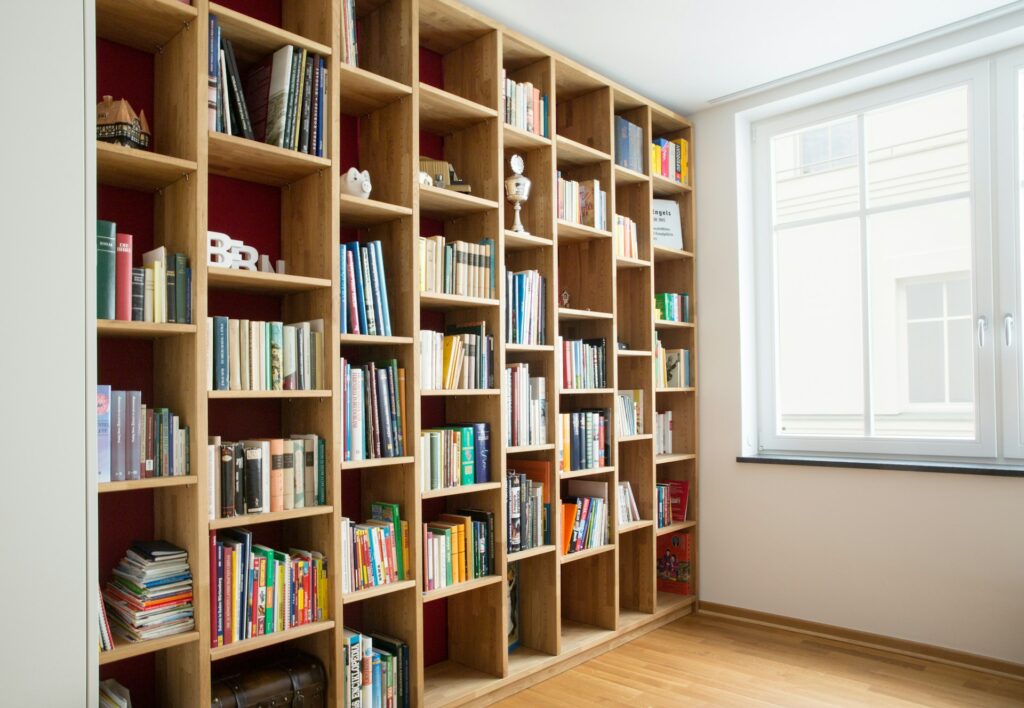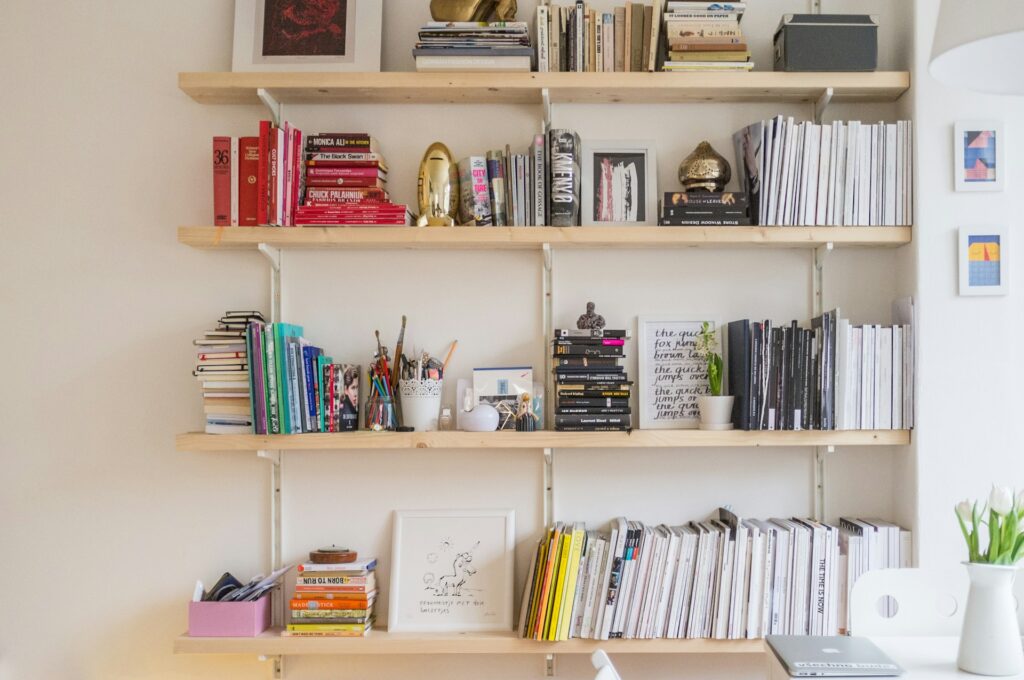In today’s fast-paced world, having a quiet sanctuary where you can escape into the pages of your favourite books can be a true luxury. Designing a home library enhances your reading experience and adds a touch of elegance and personality to your living space. Whether you’re a bookworm looking to create a cosy corner or an avid collector seeking to showcase your literary treasures, this guide will walk you through everything you need to know to design your home library.
Introduction
A home library is more than just a room filled with books—it’s a retreat that fosters creativity, relaxation, and intellectual stimulation. Beyond its functional purpose, a well-designed library can become the heart of your home, where you can unwind, delve into new worlds, or find solace in the written word.
1. Planning Your Home Library

Before diving into the design process, take some time to plan and envision how you want your home library to look and feel.
Define Your Goals and Needs
Start by defining the primary purpose of your home library. Is it a space for quiet reading, a study area, or a showcase for your book collection? Understanding your goals will guide the design decisions you make.
Assess Available Space
Consider the available space in your home for the library. It could be a spare room, a corner of the living room, or even a niche under the stairs. Evaluate the layout and dimensions to determine how best to utilize the space.
Budget Considerations
Set a budget for your home library project. Determine how much you’re willing to invest in furniture, decor, lighting, and any renovations or modifications needed. This will help prioritize your design choices.
2. Choosing the Right Location
The location of your home library can significantly impact its functionality and ambiance. Here are some considerations:
Ideal Locations
- Quiet Areas: Choose a location away from noisy areas of the house, such as kitchens or high-traffic hallways.
- Natural Light: Opt for a space with ample natural light, as it enhances the reading experience. Consider large windows or a room with good exposure to sunlight.
Maximizing Space Efficiency
- Small Spaces: If working with limited space, consider vertical storage solutions like tall bookcases or built-in shelving to maximize floor space.
3. Designing the Layout

Once you’ve chosen the location, it’s time to plan the layout of your home library to ensure it meets your functional and aesthetic needs.
Furniture Essentials
- Bookshelves: Choose bookshelves that fit the style of your library—whether traditional wooden shelves, modern minimalist designs, or built-in units.
- Seating: Incorporate comfortable seating options such as plush armchairs, a cozy reading nook with cushions and throws, or even a small sofa for lounging.
Ergonomic Considerations
- Reading Desks: If you plan to do work or study in your library, include a desk or writing table with adequate lighting.
- Comfort: Ensure seating is ergonomic and supportive for long reading sessions. Consider adjustable lighting options for different activities.
4. Selecting Furniture and Decor
Choosing the right furniture and decor is crucial for creating a cohesive and inviting home library environment.
Types of Bookshelves
- Wall-Mounted Shelves: Ideal for small spaces or creating a minimalist look.
- Freestanding Shelves: Provide flexibility and can be rearranged as needed.
- Built-In Shelves: Customizable to fit the dimensions and style of your library space.
Seating Options
- Reading Chairs: Choose comfortable chairs with good lumbar support.
- Reading Nooks: Create a cozy corner with a comfortable armchair, ottoman, and a small side table for placing books and drinks.
- Sofas: If space allows, add a sofa for lounging or hosting guests in your library.
Lighting Options
- Task Lighting: Desk lamps or adjustable floor lamps for reading and studying.
- Ambient Lighting: Overhead lights or sconces to create a warm and inviting atmosphere.
- Accent Lighting: Showcase artwork or collectibles with spotlights or picture lights.
5. Organizing Your Book Collection

Organizing your books not only enhances the visual appeal of your library but also makes it easier to find and access your favorite reads.
Sorting and Categorizing Books
- By Genre or Subject: Arrange books in sections based on genres or subjects of interest.
- Alphabetically or Chronologically: Organize books alphabetically by author’s name or chronologically by publication date.
Displaying Books Creatively
- Bookends: Use decorative bookends to keep books upright and add style to your shelves.
- Decorative Boxes and Baskets: Store smaller items like magazines, journals, or stationery in decorative boxes or baskets.
6. Personalizing Your Space
Make your home library truly yours by adding personal touches and decorative elements that reflect your style and interests.
Adding Artwork and Decor
- Artwork: Hang paintings, prints, or posters that inspire you or complement the theme of your library.
- Personal Memorabilia: Display items like family photos, travel souvenirs, or collectibles that hold sentimental value.
Creating a Cozy Atmosphere
- Textiles: Add plush rugs, cushions, and throws to create a warm and inviting reading nook.
- Greenery: Incorporate indoor plants or fresh flowers to bring a touch of nature into your library.
7. Enhancing the Reading Experience
Design your home library to enhance the pleasure of reading and create a comfortable environment for leisure and learning.
Incorporating Technology
- E-readers: Have a dedicated space for charging and storing e-readers or tablets.
- Audio Systems: Install speakers or headphones for listening to audiobooks or music while reading.
Creating a Quiet Environment
- Soundproofing: Minimize noise distractions with sound-absorbing materials or curtains.
- Comfortable Seating: Ensure chairs and sofas are ergonomically designed for extended reading sessions.
8. Maintenance and Care
Keep your home library looking its best with regular maintenance and care of furniture, books, and decor items.
Organizational Tips
- Regular Cleaning: Dust shelves, wipe down furniture, and vacuum rugs to keep the space tidy.
- Book Care: Handle books with care to prevent damage. Store them upright and away from direct sunlight to avoid fading.
Refreshing Your Space
- Seasonal Updates: Update decor with seasonal touches or rotate artwork to keep your library feeling fresh.
- Maintenance Checks: Inspect lighting fixtures and seating for any repairs or replacements needed.
9. Inspiration and Design Ideas
Explore different design inspirations and showcase examples of beautifully designed home libraries to spark creativity.
Showcase Examples
- Traditional Libraries: Highlight classic designs with rich wood finishes and antique furniture.
- Modern Libraries: Showcase minimalist styles with sleek lines and contemporary decor.
Design Ideas for Small and Large Spaces
- Small Spaces: Provide tips for maximizing storage and creating a cozy reading nook in compact areas.
- Large Spaces: Explore ideas for grand libraries with extensive book collections and multiple seating areas.
Conclusion
Designing a home library is a rewarding project that enhances your living space and enriches your lifestyle. Whether you’re creating a quiet retreat for personal reflection or a stylish showcase for your literary passions, the key is to prioritize comfort, functionality, and personal style. With careful planning and attention to detail, you can create a home library that not only meets your practical needs but also inspires your imagination and nurtures your love for reading.
Start planning your dream home library today and transform your space into a haven of literary bliss!
This comprehensive blog post provides a detailed guide for readers interested in designing their own home library, covering everything from planning and layout to furniture selection, decor ideas, and maintenance tips.
The articles you write help me a lot and I like the topic
Thank you for your post. I really enjoyed reading it, especially because it addressed my issue. It helped me a lot and I hope it will also help others.
Hi, Neat post. There’s a problem with your website in internet explorer, would check this?IE still is the market leader and a big portion of people will miss your excellent writing because of this problem.